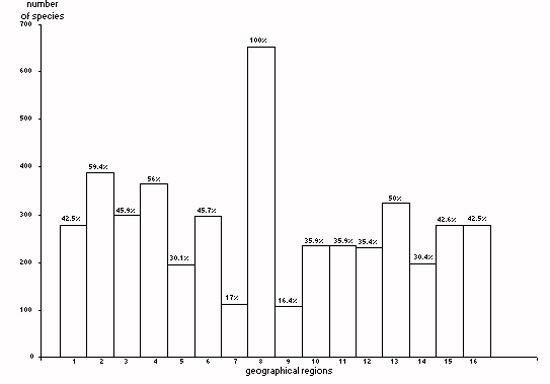
The moss flora of Thailand, with 652 taxa, is comparable to that of neighboring countries or regions, such as Borneo, Java, Malay Peninsula, Myanmar, the Philippines, and Vietnam (Table 2). Phytogeographically, Thailand is a transitional region forming a bridge between the Malayan-Philippine and Sino-Himalayan floras. In the northern part of Thailand plants in the dry lowlands are very poor, but grow vigorously in moist evergreen forests that are developing at altitude above 1,000 meters (Iwatsuki 1972). The mosses of high elevations in the north exhibit affinities to those of eastern Himalayas, Myanmar, and southwestern China (Yunnan, Sichuan, and Guizhou). Many species of the Brachytheciaceae, Entodontaceae, Thuidiaceae, and Hylocomiaceae as well as the species of Bryowijkia Nog., Calyptothecium Mitt., Dixonia Horik. & Ando, and Penzigiella Fleisch. show this affinity. In the southern part of Thailand most species occurring there belong to the Malayan elements known from Malay Peninsula, Java, Sumatra, and its archipelago as well as the Philippines. These include many species of the Calymperaceae and Sematophyllaceae, and those of Hypnodendron (C. Muell.) Lindb. ex Mitt., Mniomalia C. Muell., and Neolindbergia Fleisch. It appears that the Sino-Himalayan elements have rarely extended southwards beyond the central plain in Thailand. The Malayan-Philippine elements clearly predominate in the "Peninsula" and southeastern Thailand. There are a significant number of species that were reported from both northern and peninsular Thailand. These elements usually have much wider distributional patterns throughout East and South Asia and often have pantropic and paleotropic distribution. The diverse distributional patterns of Thai mosses are primarily due to the country's diverse climates and landscapes. The climates in the large central plain and the Korat Plateau in the east are dry and are intermediate between the monsoon regions and tropical regions. A broad zonation belt is formed centrally, which separates the country into two climatic zones. It is practical in biogeographical standpoint to divide Thailand into two floristic regions, the Sino-Himalayan region in the north and northeast and the Malayan region in the southeast and the "Peninsula". The distribution of the pteridophytes in Thailand is clearly determined by the climatic factors (Iwatsuki 1972). The floristic affinities of Thai mosses with adjacent East and South Asian countries are shown in Fig. 1.
| Country or region | No. of Genera | No. of Taxa | Publication | No. of Taxa in common with Thai mosses |
| Borneo | Touw 1978 | 277 (42.5%) | ||
| Whole China | Redfearn, Tan & He 1996 | 387 (59.4%) | ||
| SW China | per this study | 299 (45.9%) | ||
| East India | Gangulee 1969-1980 | 365 (56%) | ||
| Japan | Iwatsuki 1991 | 196 (30.1%) | ||
| Java | Fleischer 1904-1923 | 298 (45.7%) | ||
| Kampuchea | Tan & Iwatsuki 1993 | 113 (17%) | ||
| Thailand | per this study | |||
| Laos | Tan & Iwatsuki 1993 | 107 (16.4%) | ||
| Malay Peninsula | Mohamed & Tan 1988 | 234 (35.9%) | ||
| Myanmar | Tan & Iwatsuki 1993 | 234 (35.9%) | ||
| New Guinea | Koponen 1990 | 231 (35.4%) | ||
| Philippines | Tan & Iwatsuki 1991 | 326 (50%) | ||
| Sumatra | 198 (30.4%) | |||
| Taiwan | Redfearn, Tan & He 1996 | 278 (42.6%) | ||
| Vietnam | Tan & Iwatsuki 1993 | 277 (42.5%) |

FIG. 1. Floristic affinities
of Thai mosses (652 taxa). Percentage share of common species
from adjacent
regions in East Asia are shown over each column. 1. Borneo. 2.
Whole China. 3. Southwestern China.
4. East India. 5. Japan. 6. Java. 7. Kampuchea. 8. Thailand. 9.
Laos. 10. Malay Peninsula. 11. Myanmar.
12. New Guinea. 13. Philippines. 14. Sumatra. 15. Taiwan. 16.
Vietnam.